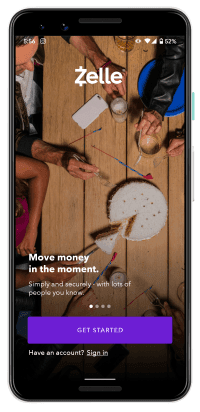Is Zelle available in Canada?
No, you need a US bank account to use Zelle. Typically, US banks only let you open a bank account if you reside in the US. So, Canadians will have to find another way of sending money to friends and family. Possible options could include bank wire transfers, PayPal, Western Union, MoneyGram or other dedicated money transfer services.
If you’re looking to send money from Canada to the US, learn more about your options here. For more information on ways of sending money domestically or internationally.
What is Zelle?
Zelle is a US mobile payment processing network developed by some of the largest American banks — Bank of America, Chase, Capital One and USAA among them. Zelle is known for transferring money nearly instantly between users who have US bank accounts that support Zelle integration.
Why should I use Zelle?
- Integrates with hundreds of banks. Zelle is partnered with more than 500 banks in the United States. Users who can access Zelle through their banking app probably won’t need to download other money transfer apps.
- Instant transfers. Transfers between two supported banks typically happen within minutes.
- No fees. Zelle is free, so sending money to other Zelle users doesn’t cost anything.
- Convenience. Users only need a phone number or email to send money to other Zelle users.
What should I watch out for with Zelle?
- US only. Both the sending and receiving bank accounts must be in the US to use Zelle.
- Only supports bank accounts. Zelle doesn’t accept credit card payments.
- Smartphone required. If banks support it, some users may be able to use Zelle through online banking. Otherwise, users are forced to use the mobile app to send money.
- No fraud protection. Sending money through Zelle is like sending cash: Once it’s sent, there’s no way to get it back — even if the funds were sent to the wrong person.
How does Zelle work?
Zelle works by moving money directly from one bank account to another. Zelle sends recipients a text or email once a payment is waiting for them. If the recipient’s bank supports Zelle, they can accept the payment through their bank app. Otherwise, the recipient uses a link provided by Zelle to accept the payment to a debit card.
Unlike Google Pay and other competitors, there is no escrow or intermediary period where the money is held by Zelle. Instead, money moves directly from senders’ bank accounts to recipients’ accounts in as little as a few seconds. Zelle is free to use, but users should check with their bank to make sure they won’t pay withdrawal or transfer fees when using Zelle.
What banks use Zelle?
- Ally Bank
- Bank of America
- BMO Harris Bank
- Capital One
- Chase
- Citi
- Discover Bank
- Fidelity Bank
- Fifth Third Bank
- Morgan Stanley
- Pinnacle Bank
- PNC Bank
- Redwood Capital Bank
- TIAA Bank
- TD Bank
- US Bank
- USAA
- Wells Fargo
How to use Zelle
Whether Zelle is easy to use depends on whether or not users can access it through their bank.
How to send money with Zelle
Sending money with Zelle can be done in just a few steps, either through mobile banking, the web or the Zelle mobile app for Android and iOS. If you have a US bank account, simply follow these steps:
- Set up your account. Log in to your current bank’s online system and register your email address/phone number with Zelle OR download the Zelle app and create an account.
- Send your payment. Choose your recipient, the amount you’re transferring and your payment method. Review your information and send.
- Zelle notifies your recipient. Your recipient receives an email or text with instructions on how to receive the transfer. If your recipient is not registered with Zelle, they’ll be prompted with a one-time setup.
- Zelle deposits your money. Your transfer is deposited into your recipient’s bank account, typically in minutes.
How to receive money with Zelle
Receiving money with Zelle shouldn’t take long after receiving your payment notification, but payments through a debit card may take a few days or more.
- Confirm payment. You’ll receive a text message or email when you’ve been paid through Zelle. Select the link inside of this payment notification.
- Connect your bank. If your bank is a Zelle partner, select it from the list or download the Zelle app and enroll using a Visa or Mastercard debit card.
- Confirm your account. After connecting Zelle to your bank or debit card and confirming it, you’ll be given a timeline for payment.
- Access your money. Zelle banks will often receive payments instantly, while payments to a debit card can take a few business days.
Zelle transfer limit
The Zelle weekly limit is set to $500 if you don’t have an account with a Zelle participating bank. For major banks that partner with Zelle, the Zelle limits are:
| Zelle limits | Daily sending limit | 7-day sending limit | 30-day sending limit |
|---|---|---|---|
Bank of America | $3,500 | $10,000 | $20,000 |
Chase — personal checking | $2,000 | $14,000 | $16,000 |
Chase – Private Client | $5,000 | $35,000 | $40,000 |
Citibank — Basic Account | $2,500 | $15,000 | $15,000 |
Citibank — Priority Account | $5,000 | $20,000 | $20,000 |
PNC | $1,000 | $5,000 | $5,000 |
TD Bank — Instant transfer | $1,000 | $5,000 | $5,000 |
TD Bank — 3-day transfer | $2,500 | $10,000 | $10,000 |
USAA | $1,000 | $2,500 | $10,000 |
Wells Fargo | $2,500 | $17,500 | $20,000 |
Unfortunately, many banks don’t make the limits known, and all bank Zelle sending limits can change at any time. Contact your bank directly for the most up-to-date information.
Can I use Zelle if my bank doesn’t support it?
Yes, but it will take at least a few days and may not be free. Your options include:
- Signing up with the Zelle app. You may still be able to use Zelle even if your bank isn’t supported by downloading the Zelle mobile app and connecting your debit card. This won’t work for all banks, though, and transfer speeds are slower than when using a Zelle partner bank.
- Using an alternative service. Alternative domestic transfer options include Google Pay, Apple Pay and more.
- Using a money transfer company. Look to digital money specialists if your recipient doesn’t have a bank account or prefers a cash pickup.
Zelle reviews
Because Zelle works primarily with partner banks and the service is included in the apps of many major US banks, there aren’t many Zelle reviews online. Zelle hasn’t claimed its Trustpilot profile, but its parent company Early Warning earns an A+ through the Better Business Bureau.
Some users on Reddit mention that Zelle is difficult to deal with when trying to sort out incorrect transactions, and one of the most common solutions is to contact your bank instead of contacting Zelle.
Is Zelle safe?
Zelle is used by hundreds of US banks and transfers money directly between bank accounts. However, even though money should be safe in Zelle’s hands, user errors can still occur.
If you plan to send money through Zelle, follow these key tips to make your transfer safer.
- Do you know the recipient? Only send Zelle transfers to people you know and trust. Zelle should be used to pay friends, family, coworkers and the like — Zelle should not be used to pay strangers.
- Are you being scammed? If the item you are about to buy online and pay for with a Zelle transfer seems too good to be true, chances are it is. Zelle offers no buyer protection, so if you get scammed, you probably won’t get your money back. Use a service that offers buyer protection, like PayPal, when making purchases online from strangers.
- Would you send cash? Treating a Zelle transfer like you’d treat cash is a great way to make sure you stay safe. You wouldn’t send an envelope of cash without double-checking the address, so always look twice at the mobile phone number or email before confirming your transfer.
Is there a Zelle app?

Yes, Zelle has an app on both Google Play and the App Store. The app makes it possible to:
- Connect nonpartner bank accounts. Enroll using a Visa or Mastercard debit card to connect your US-based checking account.
- Log in using biometrics. Both face and fingerprint recognition can be used to log in.
- Send money on the go. Quickly pay friends and family members with a few taps after a shared meal or day shopping.
- Request money. Send money requests through the app to make sure you get paid back without delay.
Ratings accurate as of March 16, 2021.
| Google Play Store | 4.3 out of 5, based on 65,778 customer ratings |
| Apple App Store | 4.8 out of 5, based on roughly 291,000 customer ratings |
What else can I use Zelle for?
Zelle is best for sending money to friends and family but offers some additional features that can be useful in the take right circumstances.
- Using Zelle with a small business. Zelle supports transactions between users and small businesses so long as the small business’ bank account is a registered Zelle partner. Only use this service to pay small businesses that you trust, as you won’t be able to cancel payments through Zelle if you are unsatisfied.
- Using Zelle for disbursements. After creating your account and enrolling with Zelle, you can use your Zelle account to receive disbursement payments from organizations, companies, the government and more. Typical reasons for using this service include insurance payouts, claim settlements, refund checks and similar situations.
Bottom line
Zelle is a straightforward way to send money from your bank account directly to the bank account of a friend or loved one. However, things get a bit more complicated when you bank at an unsupported bank and have to register your account using a debit card. To see how Zelle stands up to competitors in the domestic money transfer field, head over to our guide on sending money.
Frequently asked questions
How do I get my money from Zelle?
You need to enroll with Zelle to receive your money.
- Select the link in the payment notification you received.
- Find your bank or credit union in the provided list. If your bank isn’t supported, you’ll have to download the Zelle app and enroll using a Visa or Mastercard debit card.
- Follow the provided instructions to enroll and collect your payment.
Are there Zelle fees?
No, Zelle does not charge any fees for its service. However, users may be charged a fee by their bank, so they should check their account terms of service or call their bank before using Zelle.
What happens if a Zelle payment doesn’t go through?
The payment will be refunded in full to the sender’s account after 14 days if the recipient does not accept it during this time.
More guides on Finder
-
Alternatives to TorFX
Looking for alternatives to TorFX for sending money abroad? Check out these reputable money transfer services.
-
How to pay off an overseas debt
Paying off an overseas debt with an international money transfer can lead to huge savings on fees and interest.
-
How to send money to someone without a bank account
Transfer agents, mobile wallets and online credit card payments don’t necessarily require a bank account.
-
Apps like Remitly
Browse money transfer services like Remitly to see if you can send send money overseas faster and cheaper.
-
10 apps like Venmo in Canada
We compare 10 Venmo alternatives to help you find the mobile payment app that suits you.
-
4 Wise alternatives in Canada
Looking for a money transfer service like Wise? Check out these four Wise alternatives.
-
Best money transfer apps
Fast, affordable, safe and easy to use — these are the best money transfer apps in Canada.
-
Fastest ways to make a money transfer
Learn more about transferring money overseas quickly, easily and safely in an emergency.
-
How long does an international wire transfer take?
Ever wondered how long it takes for an international wire transfer to arrive in your recipient’s bank account? Find out here.
-
What details do I need for an international money transfer?
What bank account details do you need to provide to send or receive an international money transfer? Your guide here.

